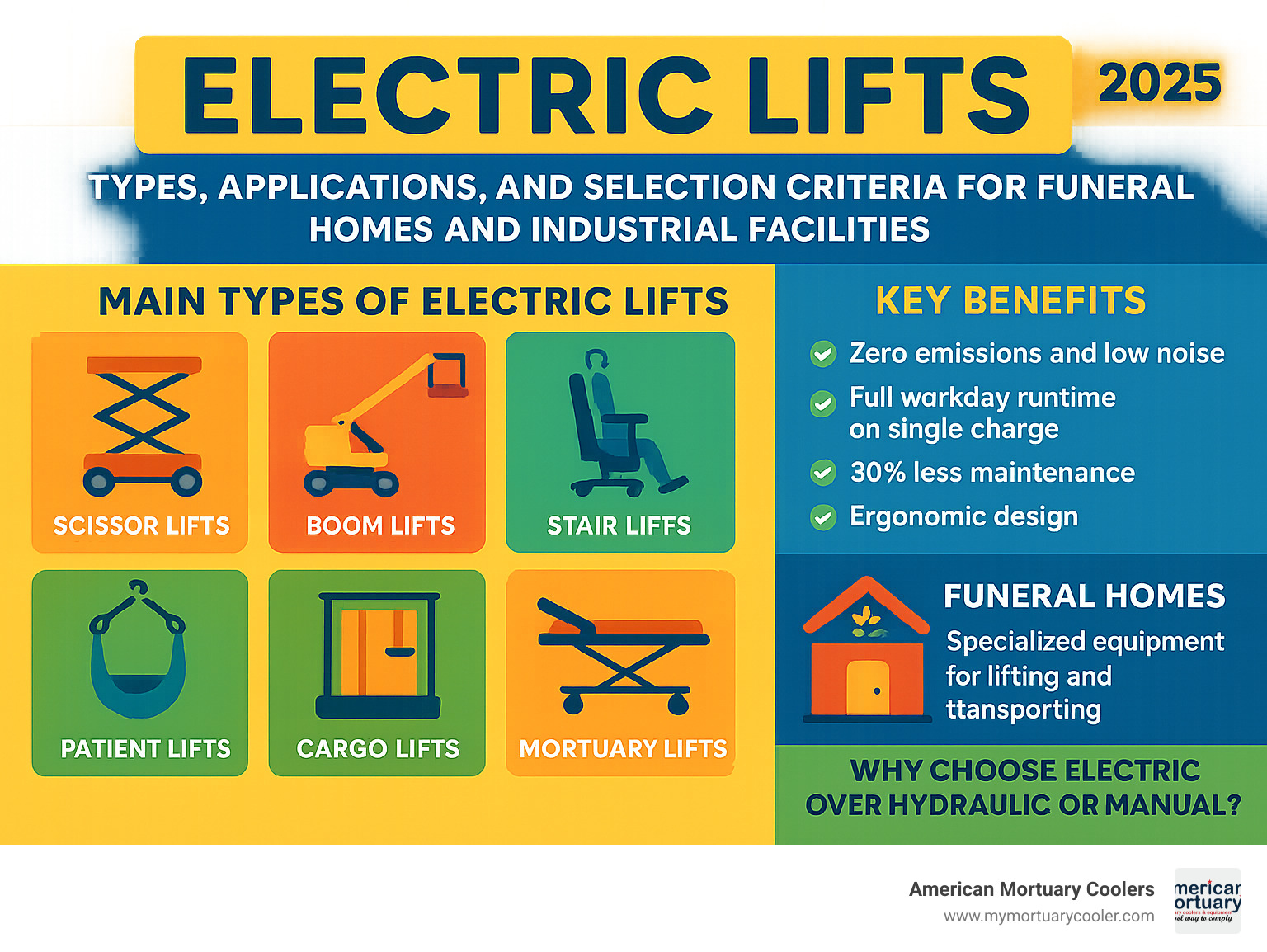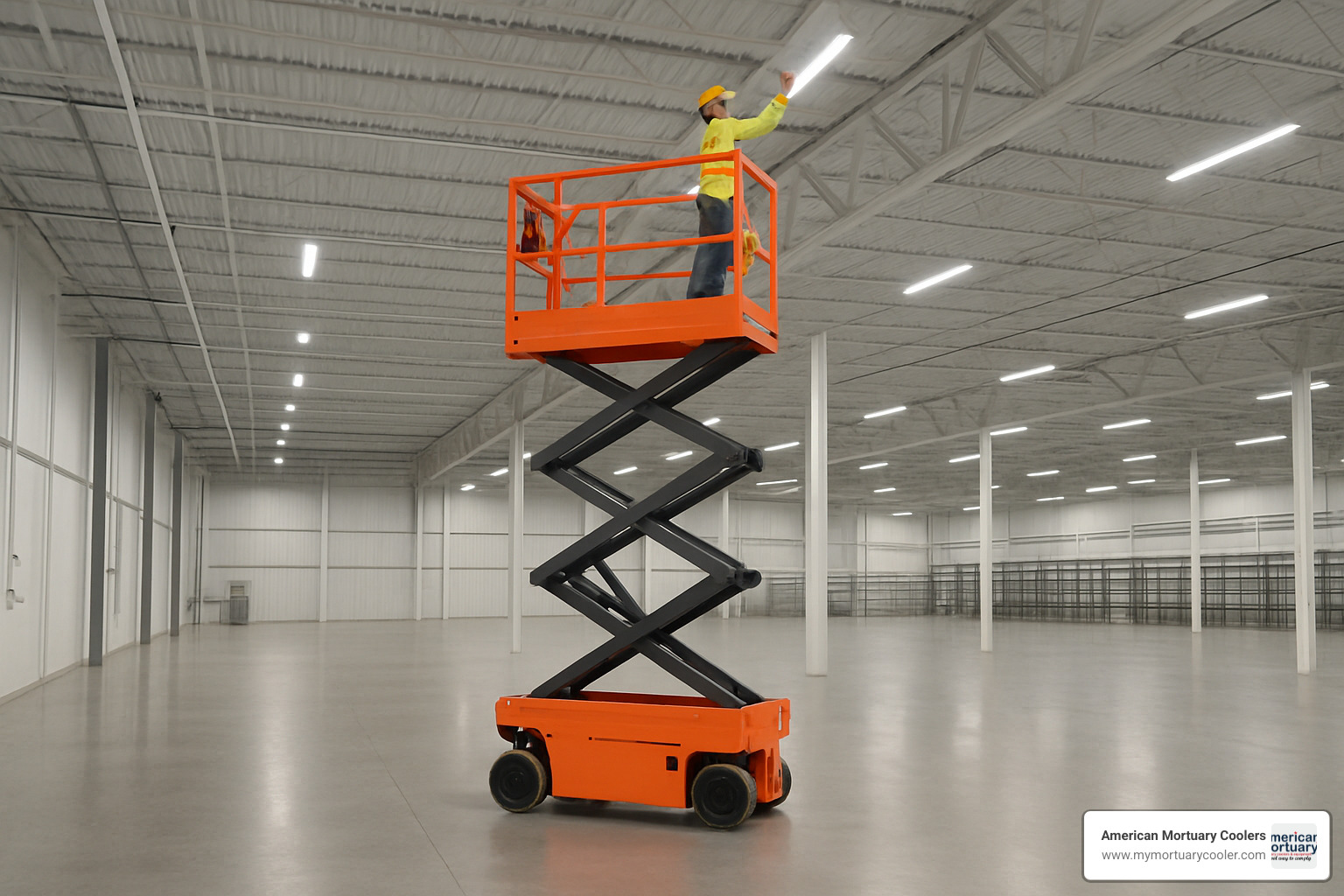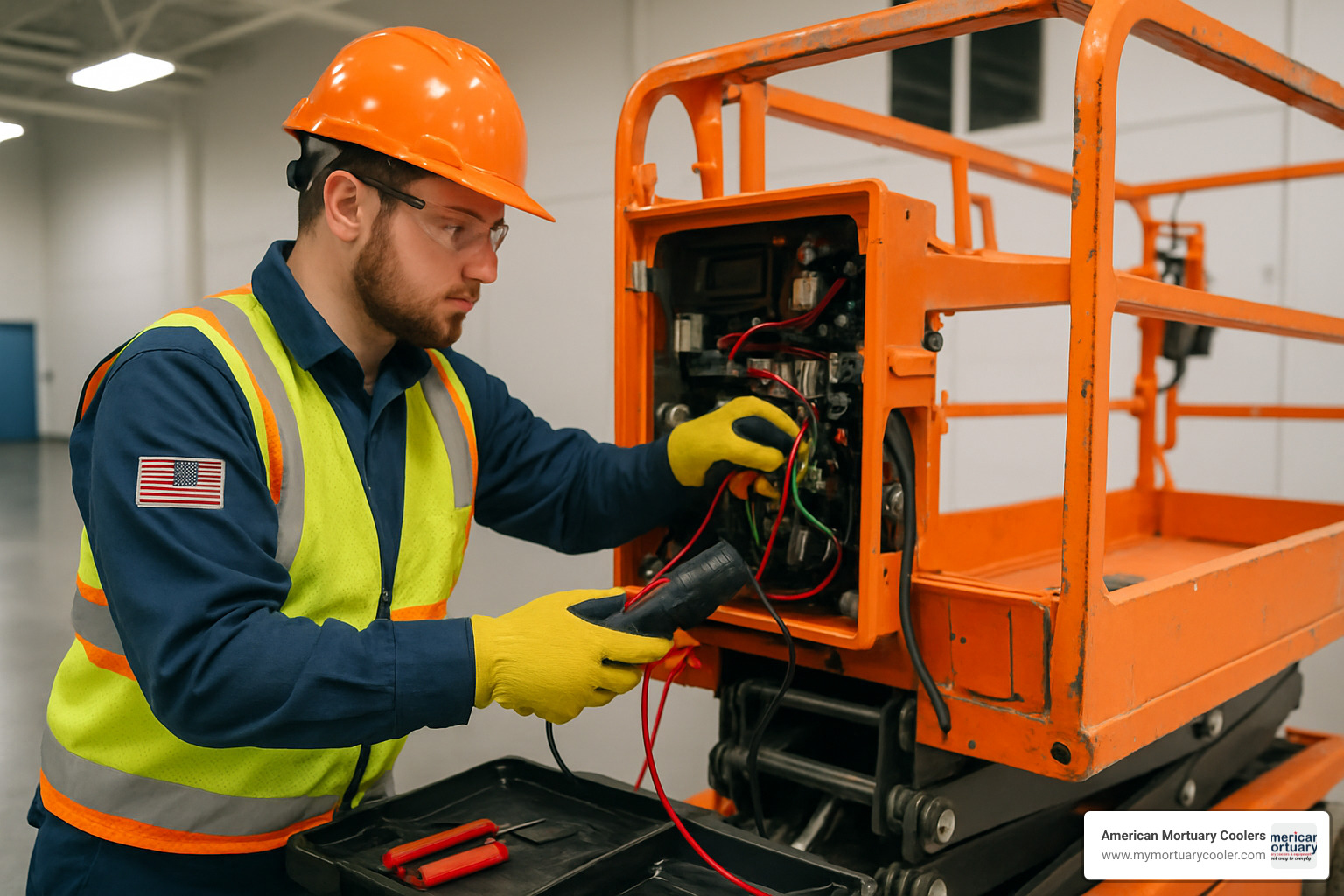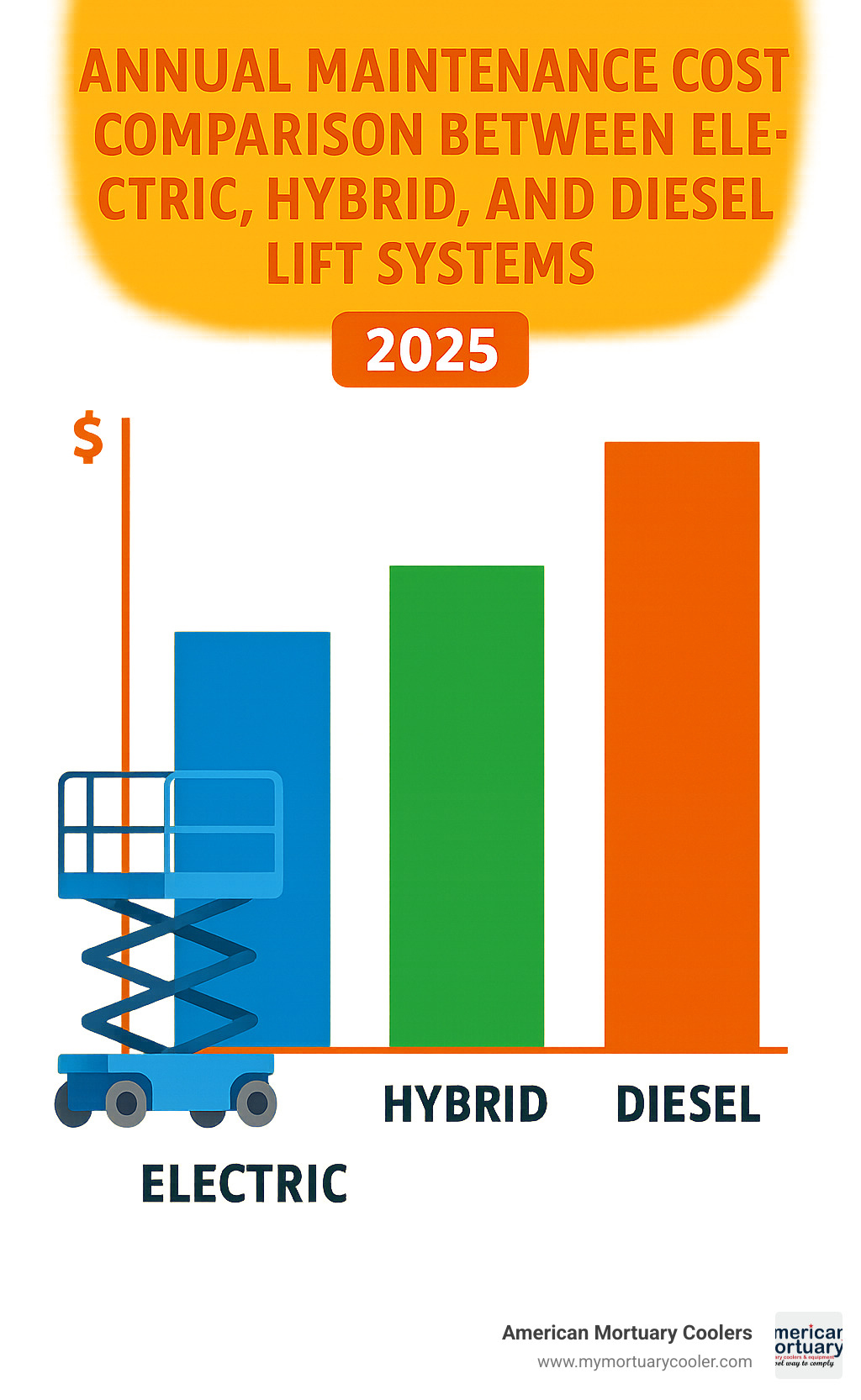Why Electric Lifts Are Changing Modern Workplaces
Electric lifts are battery-powered or plug-in lifting equipment that eliminate hydraulic fluid and diesel emissions while providing quiet, efficient vertical mobility for people and materials.
Main Types of Electric Lifts:
- Scissor lifts - Compact platforms for indoor/outdoor work up to 51+ feet
- Boom lifts - Articulating arms with 65+ foot reach capability
- Stair lifts - Battery chairs supporting up to 500 lbs
- Patient lifts - Medical mobility aids for healthcare facilities
- Cargo lifts - Material handling from 309 lbs to 1,000+ lbs capacity
- Mortuary lifts - Specialized equipment for funeral home operations
Key Benefits:
- Zero emissions and low noise operation
- Full workday runtime on single charge (8+ hours)
- 30% less maintenance than diesel counterparts
- Ergonomic design reduces workplace injuries
The funeral industry has particularly accepted electric lifting solutions. As one mortuary equipment user noted: "The mortuary stretcher is great! We already used it for 450 pounds... was smooth and easy to operate."
Genie reports that 70% of their mobile platform lineup is now electrified to meet growing demand for cleaner, quieter operations. Companies find that electric models often pay for themselves through reduced maintenance costs and improved productivity.
I'm Mortuary Cooler, a national-level supplier specializing in mortuary equipment including electric lifts for funeral homes across the country.

Why This Checklist Matters
Manual handling injuries cost businesses thousands annually in workers' compensation claims. The Bureau of Labor Statistics ranks lifting-related back injuries among the top workplace injuries.
Funeral homes reduce injury rates by 40% after switching from manual body handling to electric mortuary lifts. The initial investment typically pays for itself within 18-24 months through reduced insurance premiums and fewer worker compensation claims.
Electric lifts address three critical pain points:
- Ergonomic stress - Repetitive lifting damages employees over time
- Operational efficiency - Electric lifts move materials faster and more precisely
- Regulatory compliance - OSHA expects employers to provide mechanical lifting aids when feasible
Understanding the Tech Behind Electric Lifts
Modern electric lifts feature sophisticated engineering with AC drive systems that provide variable speed control and capture energy through regenerative braking when lowering loads. Lithium-ion batteries have revolutionized runtime and charging speed compared to old lead-acid batteries.
The Genie Z-60 DC electric boom lift reaches 65 feet 7 inches high with 36-foot horizontal reach, running silently on battery power for an entire workday.
How electric lifts work
Electric lifts operate through seamless coordination between batteries, motors, and smart controls. Your battery pack sends DC power to a motor controller that converts power to the right voltage for drive motors and lift motors. Sensors monitor position, load, and system status, while intelligent chargers adjust charge rates based on battery condition and temperature.
The hydraulic system handles heavy lifting, but an electric pump replaces the noisy diesel engine, providing proven hydraulic reliability with clean electric efficiency.
Key components you'll inspect
Drive motors should be sealed, brushless designs that operate quietly with smooth acceleration. Lift cylinders need leak-free seals and smooth operation throughout the full range of motion.
Control panels should feel intuitive with clear displays showing battery status and error codes. Touch screens are becoming standard on premium models. Battery compartments should offer easy access, proper ventilation, and secure mounting for maintenance without special tools.
Types & Applications of Electric Lifts

Scissor lifts dominate the electric lift landscape, providing stable platforms for serious work. The Genie GS-4655 E-Drive reaches 51 ft 9 in working height while supporting 770 lbs, running whisper-quiet on battery power.
Boom lifts provide horizontal reach around obstacles. Electric versions like the Genie Z-60 DC offer crucial reach without noise and fumes of diesel models.
Vertical mast lifts excel in cramped quarters where scissor lifts won't fit. Stair lifts like the MOBI EZ Battery model haul 500 lbs up stairs for 1.5 hours on a single charge.
Patient lifts serve healthcare with electric outlet, motor, battery, and manual operation options. Cargo lifts range from 309 lbs hand trucks to heavy-duty units handling 1,000+ lbs.
Mortuary lifts handle funeral home operations uniquely, with MOBI battery-powered models supporting over 1,000 lbs while reaching 80+ inches, weighing just 395 lbs for easier maneuvering.
Electric lifts for indoor vs outdoor use
Indoor electric lifts prioritize whisper-quiet operation and floor protection. They produce zero emissions, keeping air quality pristine while meeting safety standards. Compact dimensions steer doorways easily, while non-marking tires protect expensive flooring.
Outdoor applications demand tougher construction and better surface grip. Quality electric lifts feature sealed electrical components, corrosion-resistant materials, and temperature-compensated charging systems.
Industry-specific use cases
Construction sites increasingly use electric lifts for indoor finishing work where noise matters. Warehousing operations appreciate quiet precision for loading and high-bay maintenance.
Healthcare facilities require zero-emission lifts for patient safety. Funeral homes need equipment that eliminates noise and emissions inappropriate in respectful settings. More info about mortuary lifting equipment explains specific requirements.
Retail environments demand equipment that won't disturb customers during maintenance. Aviation facilities rely on electric lifts for aircraft maintenance where emissions must be minimized.
The Ultimate Selection Checklist
Choosing the right electric lift requires asking the right questions upfront. Focus on total value rather than just price - cheaper lifts that break down frequently cost more long-term.
Start with load requirements. Consider both maximum and typical daily loads. Working height needs careful measurement with safety margin. Platform size must accommodate operators and tools safely.
Consider terrain and environment. Indoor slab floors allow compact, quiet models with non-marking tires. Outdoor applications need weather protection and better traction.
Power source selection depends on usage patterns. Battery electric works for most applications with 6-8 hour runtime. Hybrid models offer extended operation but cost more.
| Feature | Battery Electric | Hybrid Electric | AC Plug-in Electric |
|---|---|---|---|
| Runtime | 6-8 hours | 1 week (fuel mode) | Unlimited (cord length) |
| Emissions | Zero | Low (fuel mode only) | Zero |
| Noise Level | Very Low | Low-Medium | Very Low |
| Maintenance | Low | Medium | Lowest |
| Initial Cost | Medium | High | Low |
| Operating Cost | Low | Medium | Lowest |
Safety features and certifications are essential. Ensure lifts meet OSHA requirements and industry-specific standards. Calculate return on investment including reduced worker compensation claims, increased productivity, and lower maintenance costs.
Battery vs Hybrid vs AC Electric Lifts
Battery electric lifts represent the sweet spot for most applications - simple, reliable, and surprisingly powerful with 8+ hours runtime. They're whisper-quiet, essential for funeral homes.
Hybrid electric lifts offer versatility at higher cost, operating in electric mode for quiet indoor work or fuel mode for extended outdoor operations.
AC plug-in electric lifts provide unlimited runtime when outlets are available, offering lowest operating costs but limited by cord length.
Feature must-haves for electric lifts
Non-marking tires should be standard for floor protection. Pothole protection systems prevent damage from uneven surfaces. Telematics systems monitor battery health and track usage patterns. Quick-charge capability enables multi-shift operations.
For budget-conscious buyers, used equipment cost tips can help identify quality pre-owned options. Match features to actual needs rather than paying for unused capabilities.
Ownership Essentials: Safety, Maintenance & Compliance

Owning electric lifts requires sustainable safety and maintenance programs. Electric lifts are inherently more reliable than diesel counterparts, with Genie's data showing significantly less maintenance and fewer repairs.
Daily inspections should verify battery charge levels, examine connections for corrosion, check hydraulic fluid levels, and inspect tire condition and safety systems. Weekly detailed inspections include thorough cleaning and component examination. Monthly maintenance focuses on battery care and electrical connections.
Certifications electric lifts must meet
ANSI A92 standards form the foundation of aerial work platform safety. UL listing ensures electrical components meet safety standards. OSHA compliance requires proper operator training and documented inspections. CE marking matters for European markets, while FDA approval is essential for medical patient lifts.
The MOBI EZ stair chair carries FDA, CE, and ISO 9001 certifications, meeting multiple international safety standards.
Keeping electric lifts safe & reliable
Battery health determines reliable performance. Modern lithium-ion batteries include management systems preventing overcharging and deep discharge, but need proper care regarding temperature extremes and charging cycles.
Software updates keep control systems current with latest safety features. Record keeping serves regulatory compliance and warranty protection. Facilities maintaining detailed service records experience 30% fewer emergency repairs.
Raising the Bar: The Best Electric Mortuary Body Lifts Reviewed provides specific maintenance guidance for funeral home applications.
Pricing, Brands & Emerging Trends
Entry-level electric lifts start around $15,000-$30,000 for basic scissor lifts. Mid-range options ($30,000-$60,000) offer the best ROI with lithium batteries and improved safety systems. Premium models ($60,000+) include hybrid systems and specialized features.
Genie leads the market with 70% of their platform lineup electrified. JLG competes with focus on durability and ease of use. MOBI specializes in medical and mortuary applications with USA manufacturing.
Technology advances include lithium-ion batteries replacing lead-acid systems, hybrid boom lifts for versatility, and emerging IoT diagnostics and autonomous navigation features.
What impacts the price of electric lifts
Capacity requirements have the biggest pricing impact. Reach capabilities add substantial cost for boom lifts. Smart features like telematics and touch-screen controls command premium pricing but often justify costs through improved productivity.
Warranty coverage varies dramatically and impacts total ownership cost. Current supply chain factors affect both pricing and delivery times, with semiconductor shortages and rising battery costs extending delivery times.
Future innovations to watch
Solid-state batteries could double runtime while reducing weight. Self-parking systems will automatically position lifts for charging. Remote operation capabilities allow expert technician assistance. Artificial intelligence integration will optimize battery usage and predict maintenance needs.
As mortuary equipment specialists, we're excited about innovations benefiting funeral homes specifically, with quieter operation, zero emissions, and improving reliability making electric lifts increasingly attractive.
Frequently Asked Questions about Electric Lifts
What weight capacities do most electric lifts handle?
Electric lifts handle 500 to 1,500 pounds typically. Compact scissor lifts start around 500 pounds, while the Genie GS-4655 E-Drive offers 770-pound platform capacity. Battery-powered hand trucks handle up to 309 pounds.
Specialized applications demand higher capacities. Mortuary lifts handle over 1,000 pounds while maintaining quiet operation. The MOBI EZ stair chair supports up to 500 pounds while weighing just 66 pounds itself.
Always check both platform and lifting capacity specifications and include safety margins for operators, tools, and materials.
How long can an electric lift run on one charge?
Modern electric lifts provide 6 to 8 hours of continuous operation - a full workday for most applications. Genie designs their electric scissor lifts to run all day without recharging.
The MOBI EZ stair chair operates for 1.5 hours on a single charge - enough for 30 trips up a 5-story building. Heavier loads, cold weather, and rough terrain drain batteries faster. Lithium-ion batteries outperform lead-acid alternatives.
Do electric lifts really cost less to maintain than hydraulic models?
Yes - electric lifts typically require 30% less maintenance than hydraulic or diesel alternatives. Genie reports their electric and hybrid lifts require less maintenance and fewer repairs.
Advantages include no hydraulic fluid changes, fewer moving parts, regenerative braking reducing brake wear, and sealed electric motors needing minimal service. However, consider battery replacement every 3 to 5 years in total cost calculations.

Conclusion
Choosing the right electric lifts requires understanding your specific needs and thinking beyond upfront cost. After helping countless funeral homes and businesses nationwide, the right electric lift transforms daily operations while wrong choices create ongoing problems.
Safety should always be your first priority. Ensure any lift meets safety standards and has proper certifications for your industry. Think total cost of ownership - electric lifts might cost more upfront but typically save money through lower maintenance, reduced energy bills, and fewer worker injuries.
Match equipment to actual needs, not theoretical maximums. Focus on daily operations rather than overspending on unused features. Consider future needs - select equipment that adapts to evolving requirements.
For funeral homes, The Ultimate Guide to Choosing a Mortuary Lift System provides specialized guidance for mortuary operations.
At American Mortuary Coolers, we help funeral directors across the contiguous 48 states find the right electric lifts for their facilities. From Tennessee, we've seen how proper equipment selection improves safety, efficiency, and service dignity.
The shift to electric is happening now. Modern electric lifts offer performance matching traditional equipment while providing cleaner, quieter operation. With proper selection and maintenance, these lifts deliver years of reliable service while protecting your people.
Ready to explore how electric lifts can improve your operations? We're here to help you steer options and find the perfect solution for your unique needs.
















